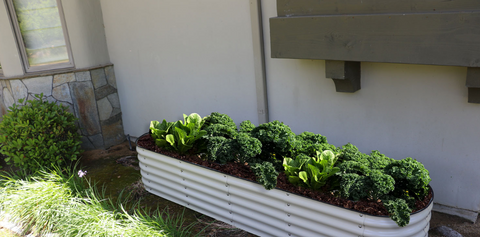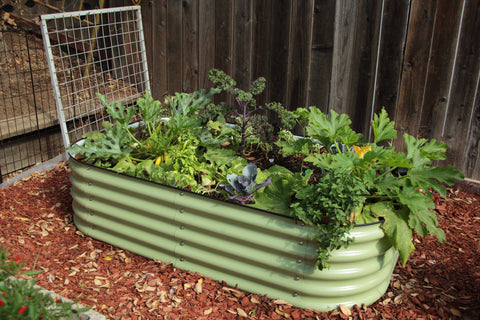How To Plant Shade Vegetables On Raised Garden Beds
Not all plants can stand a whole day's direct sunlight; Some of them burn easily. If your garden is located in an area that receives sunlight all day, consider planting plants on a raised garden bed.
Shaded vegetables, in particular, thrive in a closed growth space because the conditions there are just right. Fewer and fewer weeds compete for nutrients, and the risk of infection is small. It is also easy to maintain a raised garden bed, which is very suitable for beginners and busy growers. Here's how to plant shade vegetables on a raised garden bed.
How to set a raised garden bed
Is there a small garden space? As long as the size of the raised garden bed is suitable for the space, you can turn any blank space into a beautiful vegetable field. In this guide, let's discuss how to set up a raised garden bed and what basic factors to consider to ensure a good harvest:

Step 1: Measure the area of the raised garden
The most critical step is to measure the space that you will become a raised garden, and then find a raised garden bed that fits the area. The raised garden bed is different from the traditional raised garden bed by raising the bed a few inches above the ground.
Step 2: Add potted soil
After measuring the space and assembling the raised garden beds, it is time to fill each bed with potted soil. Garden soil is not suitable for raising garden beds because it is too thick and heavy. Shaded vegetables like well drained, fluffy soil and some organic compost to increase nutrition. Do not fill the raised garden bed; Leave about 2-3 inches of drip line from the top of the bed.
Step 3: Install the drip pipe
Effective irrigation is essential because shade vegetables hate standing water. After filling raised garden beds with potted soil, set drip lines and cover them with more potted soil.
Step 4: Plant shade vegetables
With the drip pipe installed, the raised garden bed can now be planted with shade vegetables. You can use seed packs to grow crops from seeds – just follow the planting direction. If you plant the seeds directly into the soil, dig a hole, pop the seeds out, and then cover them with soil. Water regularly until the seedlings sprout. No matter which way you plant vegetables, you should give each seedling room to grow.
Shaded vegetables to grow in raised garden beds
Many plants are surprisingly shade tolerant. Here is a list of plants that like shade:
- Sesame
- B Asier
- Beans
- Celery
- Cabbage
- Lettuce
- Green vegetables
- Peas
- Radish
- Rhubarb
- Spinach
- Swiss beet
- Radish and vegetable

The difference between raised garden bed gardening and underground gardening
Raised gardening is different from ground gardening because the soil is placed in an enclosed space. The soil in the raised garden bed must be modified regularly to restore the nutrients exhausted by the soil. Planting vegetables on raised garden beds is convenient for many people because weeds are easier to manage. You can protect your crops in adverse weather conditions by installing plant covers on raised garden beds.
Although underground gardening is ideal for many people because you only plant plants directly underground, it does have some disadvantages. Not everyone has space for a garden. Some garden soils are not suitable for shade vegetables. Crops planted underground have deeper and stronger roots, but because space is exposed to elements, there is a greater risk of infection and disease.
Planting vegetable plants on raised garden beds
When planting shade vegetables on the raised garden bed, the best soil combination is preferred. The perfect soil combination will provide the best start for your crops, ensure that the plants are healthy enough to resist diseases, and increase your reward during the harvest season.
You can purchase commercial potting mixtures at the nearest gardening supplies store, or create your own mixtures using different planting media. For example, you can mix potted soil with organic compost or natural fertilizer. Earthworm dung, aged dung, coconut shell, leaf mold and plant materials (straw, straw and dry leaves) are just some of the many materials you can use to improve the soil without chemicals.
Avoid using peat moss as much as possible, because the harvest speed of peatland is amazing, which affects the global carbon cycle. Use a peat free potting mixture to grow healthy plants without damaging the environment.
Techniques for planting shade vegetables and herbs
Plant shade plants on the balcony: If you have a terrace that receives sunlight at certain times of the day, you can set a raised garden bed in this area and transform the space into a vegetable garden. Other places where you can become a raised garden are sidewalks, terraces, and spaces between buildings along fence lines.

Start with herbs: Many herbs like plenty of sunshine, but some can tolerate shadows. For example, basil, thyme, mint and rosemary perform well on raised garden beds. You can use our herbal kit to grow these plants from seeds or transplant seedlings.
Choose green leafy vegetables: Most green leafy vegetables, including cabbage and lettuce, will perform well on raised garden beds. These plants have incredible shade tolerance because their leaves are larger and absorb more light.
Avoid root crops and fruits: Root crops may not perform well in raised garden beds because they require at least 6 hours of sunlight to grow. The same is true for fruit crops such as tomatoes - these plants do not tolerate shade, so they will not produce so many fruits under shade.
Any plant requiring less than 6 hours of sunlight is considered a shade plant. Shaded plants need at least 4 to 6 hours of light. Balcony, terrace and raised kitchen are shady areas, which can be turned into gardens as long as they meet the basic growth requirements of plants. Of course, if you have a series of gardening tools to build a beautiful garden full of shade vegetables, it will help!